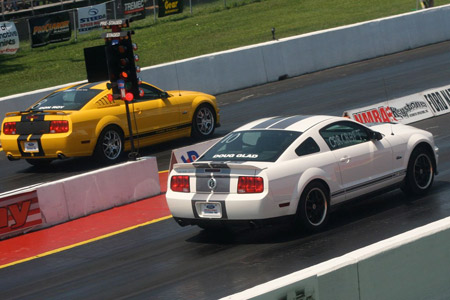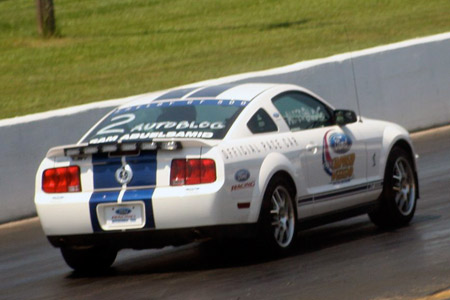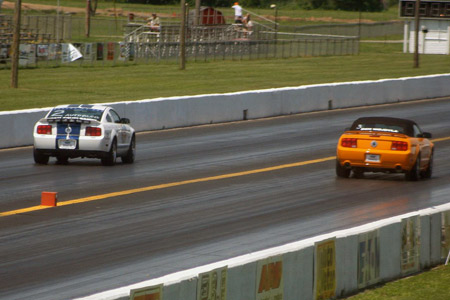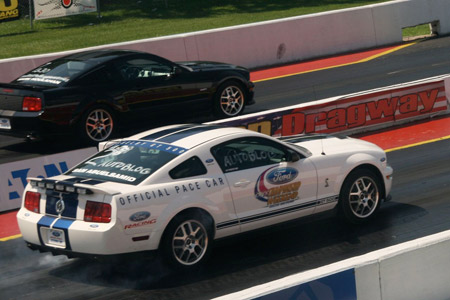Click above for a high-res gallery from the Ford Racing Invitational
I went into the Ford Racing Racing Invitational drag race this weekend with only a cursory knowledge of drag racing. Sure I was aware of all the usual suspects like Garlits, Prudhomme, Force and other famous names over the years. I knew about the kind of speeds they reached and I had a vague awareness of bracket racing and the need for consistency. But I figured "How hard can it be to go from a starting line and traverse 1320 feet in the shortest possible time?" Well, it turns out that it's a lot harder than you might think. If nothing else, I came away from this experience with with a vastly increased respect for successful drag racers.
Let's start with a brief run down of the procedure. First up, before getting to the starting line you do a couple of burnouts to warm the tires in hope of getting some extra grip. On racing slicks this undoubtedly helps. Whether it actually helps with street tires is something about which we need to consult with some tire engineers. Once your tires are warm, you pull up to the line. This is where things start to get very complicated. Read on to learn more and check out the gallery below for shots from the day showing Autoblog and its peers doing their best on the quarter-mile.
I went into the Ford Racing Racing Invitational drag race this weekend with only a cursory knowledge of drag racing. Sure I was aware of all the usual suspects like Garlits, Prudhomme, Force and other famous names over the years. I knew about the kind of speeds they reached and I had a vague awareness of bracket racing and the need for consistency. But I figured "How hard can it be to go from a starting line and traverse 1320 feet in the shortest possible time?" Well, it turns out that it's a lot harder than you might think. If nothing else, I came away from this experience with with a vastly increased respect for successful drag racers.
Let's start with a brief run down of the procedure. First up, before getting to the starting line you do a couple of burnouts to warm the tires in hope of getting some extra grip. On racing slicks this undoubtedly helps. Whether it actually helps with street tires is something about which we need to consult with some tire engineers. Once your tires are warm, you pull up to the line. This is where things start to get very complicated. Read on to learn more and check out the gallery below for shots from the day showing Autoblog and its peers doing their best on the quarter-mile.
Prior to this weekend I had never in my 42 years been to a drag strip. As I said, knowledge of the sport was cursory at best. During 17 years working as an engineer developing control algorithms and software for anti-lock brakes, traction control and stability control systems, I had done countless launches ranging from easing into the throttle to wide-open-drop-the-clutch-and-hammer-it. I could do the same thing time after time after time, but I always did it on my own time and never while sitting there watching a light tree waiting for the third yellow light.

At the drag strip you pull up until the first light turns on and then inch forward until you get the second, and then you wait. Once both cars are staged, a sequence of three yellow lights followed by a green one light up the tree. Everyone told me to go on the third yellow because by the time you move, the green light will already be lit. The time lapse for those three yellow lights is about half a second, which is not much time from when you get positioned until you have to go. Not much time at all. When the light goes green the clock starts. At the end of a run you get handed a timing slip. The first bit of information on the timing slip is your reaction time, the period from the green light until your car moves. That is, of course, unless you go to soon, which is a foul, and get disqualified.
From there, the timing slip shows various intervals starting at 60ft, 1/8 mile, 1,000ft and 1/4 mile. That 60ft interval tells a lot about your start. A short time to 60ft means you got the right combination of engaging the clutch applying the throttle. A long interval means you may have let the clutch out too fast or too slow, or applied the gas too fast or too slow. Either way, that first 60ft can mean the difference between winning and loosing. Out of 4 runs I did on Saturday (after a Friday afternoon practice rain out), I hooked up really well twice and twice I got away with the tires spinning madly.

Launching a Mustang GT500 on street tires for maximum acceleration is hard at the best of times. The stock Goodyear Eagle F1s are simply not up to the task of putting down 500+lb-ft of torque. Doing a launch when you're good and ready is one thing, but doing it against the lights is something else entirely. Even though your elapsed time through the quarter mile is what determines the winner, in qualifying your reaction time determines who you go up against in the elimination brackets. Unfortunately, my relatively poor reaction times in my two qualifying runs meant I was paired against the more experienced Mark Houlahan from Modified Mustangs and Fords in the first elimination round.

In spite of a comparatively slow reaction time in my one head to head match up against Ben Wojdyla from Jalopnik, a perfect hookup helped me take advantage of the the extra 100 hp of the GT500 compared to his blown GT. Ben had difficulty negotiating the Hurst shifter in his car, which meant that I covered the quarter mile faster at a significantly higher speed. The Hurst shifter provides shorter throws than the stock unit, but evidently doesn't like to be rushed. In the elimination round I had my best reaction time of the day, but gave it too much gas and lost time as I tried to regain traction. In the end, the driver I lost to the first round of the eliminations, Mark Houlahan, defeated Evan Smith to take home the trophy.
Once you get to the eliminations, yet another complication is thrown into the mix. Based on your qualifying times, you have to predict your ET (dial in time) and the difference between the two racers is given as a head start to the driver who has the slowest dial in time. It's important not to pick too slow a time because if you run faster than your dial in time it's called a breakout and you lose. Pick too fast a time and you give your opponent a head start. All of this stuff happens in just a matter of seconds and timing everything just right is a lot harder than it looks.

I still don't consider myself a drag racing fan preferring road racing to just going in a straight line. But I do have a lot of new found respect for anyone that can do this successfully and consistently. Every form of motorsport from drag racing to oval track to road racing has unique skill sets and comparatively few drivers have ever excelled at more than one form. I'm looking forward to trying this again next year, hopefully with a little practice beforehand.


Sign in to post
Please sign in to leave a comment.
Continue